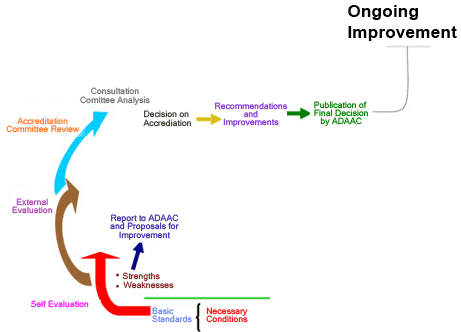La Asociación Dominicana Para el Autoestudio y la Acreditación [1] (ADAAC)
La Secretaria de Estado de Educación Superior, Ciencia, y Tecnología [2] (SEESCYT)
Background
The Dominican Republic’s institutions of higher education are accredited by the Dominican Association for Self-Evaluation and Accreditation (ADAAC). Established by national law and founded in 1987, the ADAAC is a private, not-for-profit organization with the stated mission of integrating the nation’s universities that are dedicated to pursuing institutional progress and betterment through accreditation. The objectives of the ADAAC are as follows:
- Define and approve the criteria and appropriate procedures that govern the institutional evaluation and accreditation process
- Evaluate and accredit legally recognized institutions of higher education
- Promote social responsibility at institutions of higher education
- Promote public interest in the quality of Dominican higher education
- Facilitate cooperation between similar organizations on a national and international level
While the ADAAC is responsible for accrediting Dominican institutions of higher education, the State Secretariat for Higher Education, Science, and Technology (Secretaria de Estado de Educacion Superior, Ciencia, y Tecnologia – SEECYT) is responsible for regulating the opening of new universities and the continued function of those institutions within an established framework of minimum standards. SEECYT evaluates all Dominican tertiary institutions every five years to confirm their compliance with national law. The SEECYT evaluation process is nationally mandated, while ADAAC accreditation is a voluntary undertaking. The ADAAC, as a complement to the SEECYT, sets criteria for quality higher education, promotes internal and external evaluation processes, conducts external evaluations, and accredits institutions based on the quality of their programs.
At its inception, the ADAAC received technical and financial support from U.S.-based accreditor the Middle States Association of Colleges and Schools [3] (MSA), the U.S. Agency for International Development [4] (USAID), the Inter-American Development Bank [5] (IDB), the International Institute for Higher Education in Latin America and the Caribbean [6] (IESALC), and the Dominican government. These organizations helped shape the development of ADAAC through participating in and helping fund educational workshops and academic exchanges designed to build capacity and expertise in the field of accreditation.
The ADAAC also maintains working relationships with the Colombian National Council of Accreditation [7] (CNA), the Middle States Commission on Higher Education in the United States (Puerto Rico), and the Chilean National Commission on Accreditation [8] (CNAP). The ADAAC collaborates with these organizations to engage in a regional network of shared expertise in the field of accreditation and to guarantee the transparency of the procedure though the inclusion of foreign evaluation professionals and consultants.
Accreditation as a standard procedure for institutions of higher education in the Dominican Republic, as in much of Latin America and the Caribbean, is a relatively new development. Due to factors such as increased student enrollment and the emergence of numerous private providers of education, there is increased recognition among stakeholders in higher education that effective quality assurance procedures are essential and integral to progress in the region’s universities and colleges. The higher education sector of the Dominican Republic has taken steps to address the quality of their academic institutions and could be considered a positive example in Latin America and the Caribbean of the accreditation beginning to improve education standards nationwide.
ADAAC Accreditation Process
Dominican institutions of higher education seeking accreditation must formally solicit the ADAAC to undergo the process of evaluation. Universities and colleges must provide the ADAAC with documentation of their official authorization to operate, evidence of their successful state evaluation (performed by SEECYT), evidence of at least one graduated student, and the institution must have proof of five years of uninterrupted operation.
The evaluation process consists of seven steps as follows:
- Internal Evaluation: The institution seeking accreditation organizes and completes an internal evaluation according to official ADAAC guidelines.
- Submission of Internal Evaluation: The institution in question submits an initial report on the results of the internal evaluation process and formally requests an external analysis.
- External Evaluation: The ADAAC conducts an external evaluation of the institution, utilizing academic peers with expertise in the accreditation process. The ADAAC informs the institution of their findings and a set period of time is established for the institution to provide an official response either in agreement or disagreement with the findings of the external evaluation.
- Revision and Analysis: The completed internal and external evaluations are reviewed by the ADAAC Accreditation Committee and the committee in turn makes its recommendation to the ADAAC Council of Directors.
- Further Consultation: The ADAAC Consultation Committee reviews the recommendations of the Accreditation Committee
- Decision on Accreditation: The Council of Directors scrutinizes the recommendations of both the Accreditation Committee and the Consultative Committee and reaches one of two conclusions:
- The institution is granted accreditation
- The institution receives a proposal for a plan of improvement that must be undertaken as a prior step to accreditation
- Publication of the Final Decision: The ADAAC informs the institution and the public of their decision.
 [9]
[9]Source: ADAAC [10]
ADAAC accreditation is not a permanent designation and is only valid for a period of five years, at which time an institution must again participate in the evaluation process. Universities and colleges can lose their accredited status voluntarily, for violating the organization’s standards, and for the loss of official state authorization to operate.
